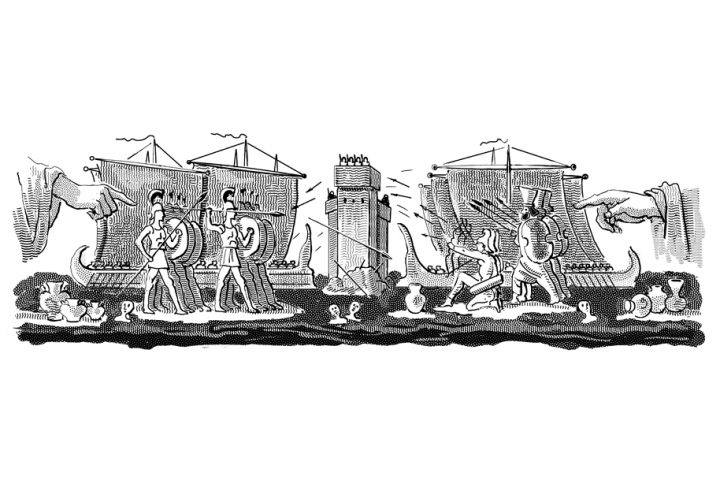While Donald Trump and Hillary Clinton were going after each other hammer-and-tong, the calmer sort of civic education continued apace, teaching what Americans have in common, or used to.
A few weeks before election day I visited the National WWII Museum in New Orleans. Founded by Stephen E. Ambrose, the celebrated author of Band of Brothers (and executive producer of the HBO miniseries) who taught history at the University of New Orleans, the museum began in 2000 as the D-Day Museum. With an expanded mission and five striking buildings (several more will come), not to mention congressional designation as the official World War II museum of the U.S., it provided a fascinating look at a time of extreme stress and almost unnatural unity in American public opinion.
In my day, long before helicopter parenting, when youngsters organized their own imagination-driven games on the playground or in the neighborhood, red-blooded American boys had basically two choices. You could play Cowboys and Indians, or you could play Soldier, which usually meant World War II soldier, the good guys versus the Germans/Nazis/Japanese. Though the Civil War and the American Revolution provided good soldierly material too, they lacked tanks, bazookas, and flame throwers. Cowboys and Indians at least had scalpings.
If you’re the right vintage, then, the National WWII Museum will delight you. Here are actual bazookas, lugers, potato mashers (German hand grenades), Higgins boats (landing craft, built in New Orleans)—and even B-17s, B-24s, and other warplanes magnificently displayed in flight, as it were, suspended from the ceiling of a cavernous pavilion. Judging from the families with small children thronging the museum, the appeal extends across the decades and generations.
Of course, it’s not just for deadly toys that World War II is remembered. Many Americans regard it as the last good war, in both the moral and strategic senses: fought against an unambiguously evil enemy, and fought through to victory. That slights the Cold War, perhaps, which was fought against equally cold-blooded enemies though not to an unambiguous victory. Harry Jaffa once compared the end of the Cold War to two heavyweights circling each other in the ring, when suddenly one collapses and dies of a heart attack. That war featured a series of small hot wars that ended in stalemate (Korea) or Western defeat (Vietnam), followed by the Soviet Union’s epic self-extinction. In America’s subsequent wars in Afghanistan and Iraq we have been unable to achieve victory, or even define it.
* * *
To its credit, the museum emphasizes the moral stakes involved, highlighting Hitler’s doctrine of the master race and the Japanese belief in their emperor’s divinity as root causes of the war. In a refreshingly unsentimental way, it reviews and accepts the arguments for dropping atomic bombs on Hiroshima and Nagasaki. Like its founder, the National WWII Museum tends to see things from the American soldiers’ point of view: though he wrote multi-volume biographies of Dwight Eisenhower and Richard Nixon, Ambrose’s most distinctive and most beloved projects, including this museum, started from oral histories he assembled by interviewing thousands of G.I.s. You will notice scores of veterans of later wars working in and visiting the complex.
“Beyond All Boundaries,” the “immersive, 4D cinematic journey through the war that changed the world,” is the rollicking 45-minute film, narrated and produced by Tom Hanks, that most visitors will want to see early in their visit. “See” is too mild a term. You will feel its rumble, smell its smoke, dodge its projectiles, as the film and its special effects transport you to Pearl Harbor, D-Day, Okinawa, and beyond. Its approach is “you are there,” drafting you into the war as a common person in uncommon, often horrific, circumstances.
The downside of the approach is that it sometimes offers the sausage’s view of the grinder. Indeed, the museum’s exhibits show the sheer mechanical killing power of the war so amply that you wonder how any G.I. ever stuck his head out of his foxhole. But they did: stories of individual courage and intrepidity abound, precisely to counter what Winston Churchill called the “mass effects” that loom so grimly in modern war.
Pearl Harbor and Hitler did wonders for American national unity. But it is not for those outside causes that any American is nostalgic. What Americans miss is that generation’s quiet confidence that their own life and liberty deserved to be defended, that their civilization, however imperfect, stood for a goodness and justice utterly lacking in the totalitarians, and that with God’s help and their own best efforts, they would prevail.
That same generation had fought bitter political battles over the New Deal, and would fight again over the Cold War and the Great Society. Americans have never shied from a good political fight, disagreement inhering in self-government. Two of our wars, the Revolution and the Civil War, pitted us against fellow countrymen. Our unity is hard-fought. That’s a good reason to visit Gettysburg, after you’ve enjoyed the marvels of the National WWII Museum.


